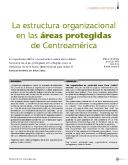| dc.contributor.author | Rey, Manuel José | |
| dc.contributor.author | Villa, José Luis | |
| dc.contributor.author | Arce, José | |
| dc.contributor.author | Guevara Moncada, Rubén | |
| dc.date.accessioned | 2016-09-12T21:53:05Z | |
| dc.date.available | 2016-09-12T21:53:05Z | |
| dc.date.issued | 2001-10 | |
| dc.identifier.issn | e-ISSN: 1659-1216 | ISSN |
| dc.identifier.uri | https://repositorio.catie.ac.cr/handle/11554/8450 | |
| dc.description | 8 páginas 6 ilustraciones, 2 tablas, 9 páginas. | |
| dc.description.abstract | Porqué nos atrevemos a aplicar un concepto de administración, como es la estructura organizacional para el funcionamiento de sistemas de áreas protegidas, si nuestra preparación académica formal ha preferido delegar el estudio de los aspectos sociopolíticos del manejo de los recursos naturales a los profesionales de las ciencias sociales? La teoría de sistemas define que al conocer la estructura y función se puede orientar nuestra intervención para obtener resultados de interés. La transformación de situaciones conlleva un análisis de oportunidades y limitaciones que debe ser evaluado. Para ello es de suma importancia contar con instrumentos de medición, con indicadores de situación aplicables. Los sistemas de áreas protegidas son sistemas sociales conformados por quienes los operan; su transformación requiere orientar a dichos operadores sobre las condiciones de: a) la estructura organizacional que desean transformar y b) la estructura organizacional idónea para su funcionamiento. Durante el presente estudio fue validado un instrumento de análisis para caracterizar la importancia de la estructura organizacional en el funcionamiento de sistemas de áreas protegidas. La aplicación de dicho instrumento fue posible no solo a diferentes esferas geográficas (regional y nacional), sino también con diferentes métodos de muestreo. | es_ES |
| dc.description.abstract | Why do we dare to apply an administration concept, such as the organizational structure for the operation of protected areas systems, if our formal academic preparation has preferred to delegate the study of the sociopolitical aspects of managing natural resources to the professionals of the social sciences? The systems theory defines that if we know the structure and its function, our intervention can be guided to obtain results of our interest. The transformation of situations involves an analysis of opportunities and limitations that must be evaluated. For that we consider important to have instruments with applicable indicators of condition. Considering that the protected area systems are social systems that consist of those who operate them; their transformation should to provide guidance to said operators on the conditions of: a) The organizational structure they wish to transform and b) the organizational structure suitable for the system's operation. During the present study an analysis instrument was validated that characterizes the importance of the organizational structure for the operation of protected areas systems. It was possible to apply said instrument at different geographical levels (regional and national) as well as with different sampling methods. | |
| dc.language.iso | es | es_ES |
| dc.publisher | CATIE, Turrialba (Costa Rica) | es_ES |
| dc.relation.ispartof | Revista Forestal Centroamericana Volumen 10, número 36 (octubre-diciembre 2001), páginas 27-34 | |
| dc.rights | info:eu-repo/semantics/openAccess | |
| dc.subject | AREAS PROTEGIDAS | |
| dc.subject | ESTRUCTURA ORGANIZACIONAL | |
| dc.subject | ESTRUCTURAS ADMINISTRATIVAS | |
| dc.subject | PROTECCION FORESTAL | |
| dc.subject | GESTION | es_ES |
| dc.subject | RESERVAS NATURALES | es_ES |
| dc.subject | ORDENACION DE RECURSOS | es_ES |
| dc.subject | SISTEMAS EXPERTOS | es_ES |
| dc.subject | AMERICA CENTRAL | es_ES |
| dc.title | La estructura organizacional en las áreas protegidas de Centroamérica | es_ES |
| dc.title.alternative | The organization on protected areas from Central America | es_ES |
| dc.type | Artículo | es_ES |
| dc.journal.issueNumber | 36 | |


